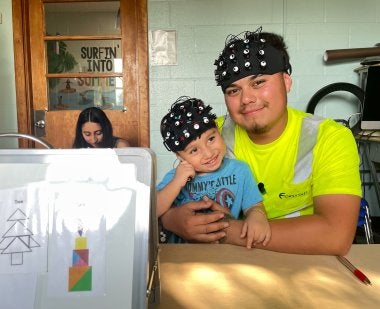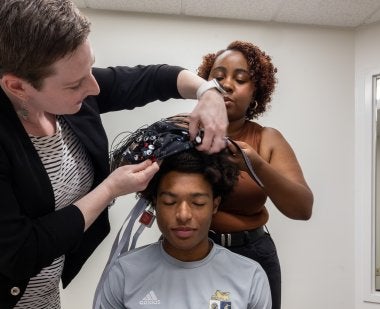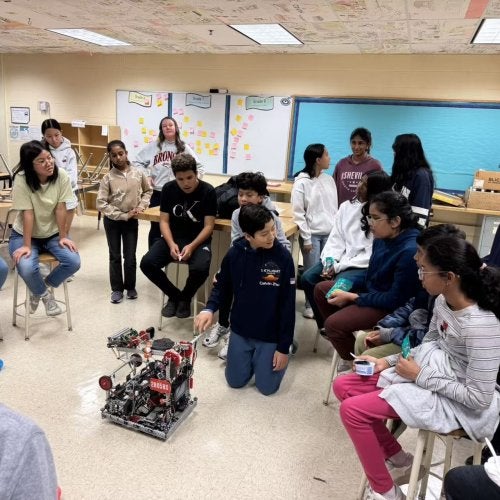
Assistant Professor Rachel Romeo and her team at the Language, Experience and Development (LEAD) Lab are pursuing innovations to include more people of color in cognitive studies, including hairstyling techniques that optimize how brain activity is measured.
Romeo embarked on this work after noticing a barrier to inclusion posed by the technology she used for her research into how early experiences affect cognitive development. Functional near-infrared spectroscopy (fNIRS) uses light beams delivered through a cap studded with sensors to track neural blood flow. But the caps were designed for people with fair skin and thin, light-colored hair. Because the technology uses light passing through the skin and scalp, it works less well for people with darker skin tones or Afro-textured hair, particularly protective styles like box braids or locs.
For this and other reasons, Black people are often excluded from neuroscience studies. Romeo sought out best practices to address this issue without harming people’s hair—and couldn’t find any. “We wanted to increase inclusion while also protecting the integrity of the hair in culturally appropriate ways,” she says.

Pursuing solutions, Romeo told her classes that she was interested in hiring a student with experience styling Black hair. That’s how Abria Simmons ’25, a psychology major and human development minor who was taking Romeo’s Paradigms and Perspectives in Human Development class, became involved. Simmons has been braiding her own hair since age 13, and she interviewed friends and relatives with professional experience styling African American hair for the project.
Simmons is testing ways to style Black participants’ hair to achieve a more direct connection between their scalps and the sensors, such as marking sensors’ locations so she can braid around them. She also advises the team on strategies for avoiding damage to Black hair.
“[Most] people doing [neuroscience] studies don’t have the knowledge or the lived experience to create best practices for African American participants,” says Simmons, who presented a poster highlighting her findings at the annual conference of Flux: The Society for Developmental Cognitive Neuroscience in September. “I want to create a path for people to come behind me.”
The LEAD Lab is working on two other projects involving families from diverse racial and socioeconomic backgrounds. One project evaluates neural synchrony (the degree to which people’s brains do the same thing at the same time) among preschool children and their caregivers, which is thought to support learning. The lab is collaborating with UMD colleagues in computer science and hearing and speech sciences on this $150,000 project, funded through UMD’s Brain and Behavior Institute. The other is a $1 million, National Institutes of Health-funded project exploring the neural bases of language and cognitive development in preschool children.
The team often brings their lab to others so people don’t have to take time off or rearrange child care to participate. For example, the synchrony studies are done at preschools during pickup or dropoff, and they use headbands rather than caps to avoid excluding people with Afro-textured hair.
“It's a win-win— we can include all families easily and ask interesting questions about the prefrontal cortex, a part of the brain that develops rapidly during these early years,” says Ellen Roche, the doctoral student in charge of the synchrony study. In addition, UMD computer scientist colleagues are developing new algorithms to enhance the signal as it travels through darker skin.
The LEAD team believes inclusion makes science better. “When you systematically exclude people, you don’t have a representative sample, and your science is biased,” Romeo says. “We want to know how all children develop, not just some.”
The researchers’ focus on partnering with study participants, such as by volunteering in the community, leads to another positive outcome—building trust. Mistrust is a significant barrier to African Americans’ participation in scientific research, due to historical events like the unethical U.S. Public Health Service Syphilis Study at Tuskegee and ongoing discrimination in the healthcare system.
Traditional medical science “can feel exploitative,” explains Ellie Taylor, lab manager and community partnerships specialist. “There is decades’ worth of research where [scientists] never interfaced with the communities they’re studying,” she says. “Rachel saw a unique opportunity to build something from the ground up and get labs invested in communities.”
For her part, Romeo is glad her work took this unexpected turn. “It was never my plan to create a new system,” she says, “but when the systems you want don’t exist, you’ve got to figure it out.”
Top photo: A child and caregiver wear headbands to participate in the LEAD Lab's neurosynchrony study. Photo courtesy the LEAD Lab


